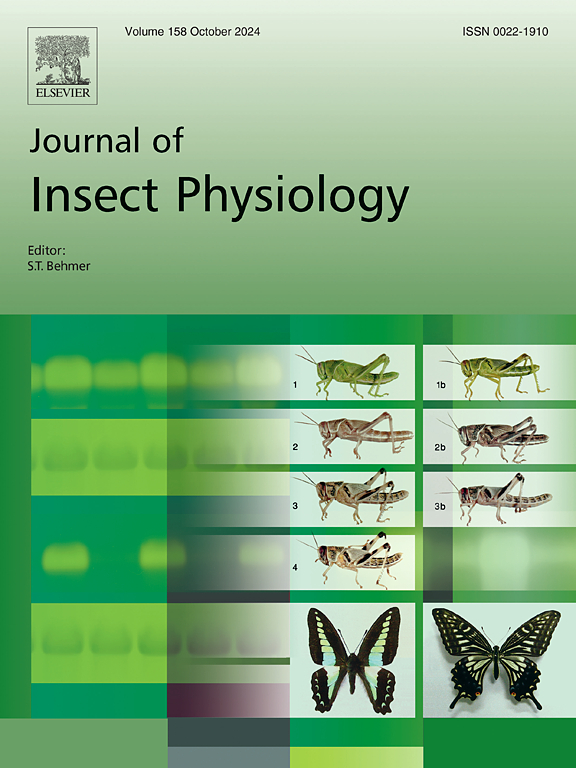沃尔巴克氏体感染改变韧皮部摄食行为,但不改变植物病毒通过半足类宿主传播。
IF 2.3
2区 农林科学
Q1 ENTOMOLOGY
引用次数: 0
摘要
感染沃尔巴克氏体和未感染沃尔巴克氏体的甜菜叶蝉亚群,圆叶蝉(半翅目:圆叶蝉科),共同出现在华盛顿和俄勒冈州的哥伦比亚盆地地区。虽然兼性内共生菌如防御汉氏菌已经明显改变了半足动物宿主的进食/探测行为,但沃尔巴克氏菌赋予昆虫宿主的行为表型,包括进食/探测,在很大程度上还没有得到充分的研究。利用电渗透技术研究了带沃尔巴克氏体和不带沃尔巴克氏体的甜菜跳叶蝉的取食/探测行为,以及相应的甜菜卷顶病毒(一种由甜菜跳叶蝉传播的韧皮部限制植物病原体)的接种量。携带沃尔巴克氏体病毒和不携带沃尔巴克氏体病毒的昆虫分别与马铃薯植物相互作用4小时,并按照既定惯例对波长进行注释。病毒接种率和韧皮部唾液分泌事件的持续时间没有变化。感染沃尔巴克氏体的昆虫摄取韧皮部的时间增加了两倍多,但尽管如此,沃尔巴克氏体感染与略微降低(而不是增强)的获取有关。无论如何,结果表明沃尔巴克氏体有可能增加其他韧皮部限制的植物病原体的获得率。本文章由计算机程序翻译,如有差异,请以英文原文为准。

Wolbachia infection modifies phloem feeding behavior but not plant virus transmission by a hemipteran host
Wolbachia-infected and uninfected subpopulations of beet leafhoppers, Circulifer tenellus (Baker) (Hemiptera: Cicadellidae), co-occur in the Columbia Basin region of Washington and Oregon. While facultative endosymbionts such as Hamiltonella defensa have demonstrably altered feeding/probing behavior in hemipteran hosts, the behavioral phenotypes conferred by Wolbachia to its insect hosts, including feeding/probing, are largely understudied. We studied the feeding/probing behavior of beet leafhoppers with and without Wolbachia using electropenetrography, along with corresponding inoculation rates of beet curly top virus, a phloem-limited plant pathogen vectored by beet leafhoppers. Insects carrying the virus with and without Wolbachia were individually recorded for four hours while interacting with a potato plant, and wavelengths annotated following established conventions. Virus inoculation rates and the duration of phloem salivation events did not vary. Wolbachia-infected insects more than tripled the duration of phloem ingestion, but despite this, Wolbachia infection was linked with marginally lower, not enhanced, acquisition. Regardless, results suggest potential for Wolbachia to increase the acquisition rate of other phloem-limited plant pathogens.
求助全文
通过发布文献求助,成功后即可免费获取论文全文。
去求助
来源期刊

Journal of insect physiology
生物-昆虫学
CiteScore
4.50
自引率
4.50%
发文量
77
审稿时长
57 days
期刊介绍:
All aspects of insect physiology are published in this journal which will also accept papers on the physiology of other arthropods, if the referees consider the work to be of general interest. The coverage includes endocrinology (in relation to moulting, reproduction and metabolism), pheromones, neurobiology (cellular, integrative and developmental), physiological pharmacology, nutrition (food selection, digestion and absorption), homeostasis, excretion, reproduction and behaviour. Papers covering functional genomics and molecular approaches to physiological problems will also be included. Communications on structure and applied entomology can be published if the subject matter has an explicit bearing on the physiology of arthropods. Review articles and novel method papers are also welcomed.
 求助内容:
求助内容: 应助结果提醒方式:
应助结果提醒方式:


